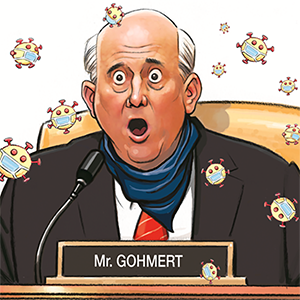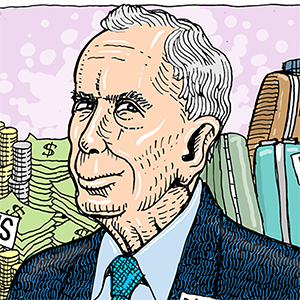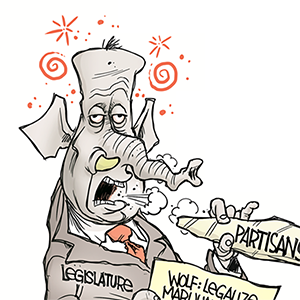States' Medicaid-directed payments targeted for potential cuts
Published in News & Features
House Republicans are considering upending the way some states fund their Medicaid programs as they scour for ways to find billions of dollars in savings from the health program.
They are looking at states’ practice of taxing health care providers, which allows the states to leverage more Medicaid funding from the federal government. Supporters say that helps states increase rates for underpaid health care providers, but critics say it is akin to legal “money laundering.”
States can use these taxes to pay for their share of Medicaid spending, which the federal government then matches. But critics say the state’s share should come from their general funds, not from health care providers, who ultimately benefit from higher Medicaid spending.
The discussions about the state-directed payments are part of efforts to find up to $880 billion in Medicaid savings to pay for an extension of President Donald Trump’s tax cuts, border security and other priorities.
“We’re having discussions on provider taxes,” Energy and Commerce Chairman Brett Guthrie, R-Ky., said in a brief interview, adding that a “number” of Republicans believe the system allows states to draw down more Medicaid money but doesn’t encourage efficiency.
“With provider taxes, it’s not really competing with everything else in the state general fund, and so we’re trying to figure out ways that we can make states more efficient with the money,” Guthrie said.
Medicaid, the $900 billion program that pays for health care for low-income children, adults and people with disabilities, is jointly funded by the states and the federal government. Any change in the federal share of spending would likely shift costs to states, which would then have to make hard decisions about what to cut or how to find additional money to fund their programs.
The directed payments have become a major way states increase payments to providers. Medicaid managed care plans are directed to increase payments to certain providers, typically with the goal of increasing access to care for beneficiaries.
Many states tax providers to finance their share of these payments, which the federal government matches at a certain rate.
It’s a completely legal arrangement, but one that needs more transparency, according to the Medicaid and CHIP Payment and Access Commission, or MACPAC, which advises Congress on policy.
And it has become a target for Republicans seeking ways to cut Medicaid, though the financing arrangements have been questioned by Democrats in the past as well.
‘Egregious and growing’
Critics of this arrangement question whether it is fair for states to use provider taxes to leverage more money from the federal government because providers can eventually get that money back through the increased payments.
“There is strong policy reasons to reduce money laundering in the program,” said Brian Blase, president of Paragon Health Institute, an influential think tank among Republicans in the White House and Congress. “I feel like the problem is egregious and growing, and states are shifting all the costs to the federal government.”
Health officials and state leaders have defended the practice, particularly in states that haven’t expanded Medicaid under the 2010 health care law, arguing that Medicaid programs often underpay providers.
“What’s important in Wisconsin is that all of our provider taxes are connected to a policy goal and a policy outcome we are trying to drive,” said Wisconsin Medicaid Director Bill Hanna, adding that the payments are intended to incentivize providers to take Medicaid patients. “The more Medicaid patients a hospital sees, the more of that sort of tax that they would get back, or above what they pay out. Whereas hospitals that don’t see many Medicaid patients ultimately do not sort of get all of their tax back. That was very intentional.”
A state can tax providers to finance their share of these payments, but only up to 6% of a provider’s net patient revenues — the so-called safe harbor rate.
According to a lobbyist familiar with discussions, Republicans are considering dropping that percentage to 5%, which the Congressional Budget Office estimates would save the federal government about $48 billion over 10 years.
The ultimate decision depends on whether Republicans can reach agreement on other Medicaid savings. They are also considering Medicaid work requirements, more frequent eligibility checks, and reducing the federal share of spending for the expansion population.
“If you do the work requirements and eligibility requirements, states are going to save money too, and so we’ve to figure out what states save money,” Guthrie said.
But lowering the safe harbor rate wouldn’t be without controversy. State hospital associations have quietly lobbied their congressional delegations, warning about potential cuts, especially in states that have not expanded Medicaid.
“There are major political obstacles. States and providers like all the money coming into them,” Blase said.
Hospitals have been among the groups lobbying hard against changing the ability of states to use provider taxes to fund state-directed payments, particularly in states that haven’t expanded Medicaid.
“Without these payments, hospitals in our states would immediately reduce services and close locations, jeopardizing health care access for millions of patients,” several hospital associations, including those in Texas, Florida and Georgia, said in February in a letter to Trump. None of those states expanded Medicaid.
Cost shift
The warnings from hospitals will likely unsettle the 12 Republicans who have raised concerns with House leadership about Medicaid cuts. “Cuts to Medicaid also threaten the viability of hospitals, nursing homes, and safety-net providers nationwide,” the members said in their letter to Guthrie, Speaker Mike Johnson and others.
The lack of data around state-directed payments makes it difficult to know if they actually improve access for patients. MACPAC has recommended Congress require states be more transparent about their Medicaid financing methods, including by reporting annually the amount of funding they get from providers.
The Government Accountability Office, in a 2023 report, warned about “rapid spending growth” in state-directed payments needing “enhanced oversight and transparency.”
States must receive approval for these payments from the Centers for Medicare and Medicaid Services, but the GAO flagged “weak fiscal guardrails” and “no consideration of payment outcomes.”
It’s not clear what would happen if Congress reduces that safe harbor rate. States could have to cover the cost with their general funds, cut rates or make hard decisions about benefits.
“It’s hard to say what the implications would be across states, but it is a cost shift to states, so it could have consequences in terms of needing to figure out how to manage that reduction in federal financing,” said Robin Rudowitz, vice president at KFF and director of the Program on Medicaid and the Uninsured.
In 2022, the federal government paid $26 billion for its share of directed payments, while states paid an estimated $12 billion, according to the GAO, though it said the actual amount is likely higher. Of that $12 billion from states, $8.4 billion was collected from providers and local governments.
Some states used only provider taxes to fund their share.
“States’ reliance on funds from providers and local governments to finance the nonfederal share raises questions about Medicaid’s federal-state partnership, particularly when those sources are used in lieu of state general funds,” the GAO report states.
The Energy and Commerce Committee aims to mark up its portion of the reconciliation package next week.
_____
©2025 CQ-Roll Call, Inc., All Rights Reserved. Visit cqrollcall.com. Distributed by Tribune Content Agency, LLC.







Comments